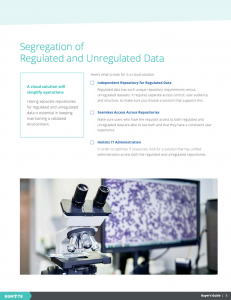
Buyer’s Guide for GxP-Compliant Document Management
According to the FDA, 30 percent of clinical trials are flagged for data-integrity violations (i.e. missing source data and corrupted audit trails). The patchwork of evolving regulations, as well as relying on non-compliant consumer-grade technology to handle data collection and storage, are often hurdles in getting your raw data into a format that is submission-ready.
To help organizations that are looking to make sense of the competing solutions for regulatory compliance, we have produced a Buyer’s Guide for GxP-Compliant Document Management for Life Sciences. It is a condensed, but comprehensive, list of the features, concepts, and requirements needed to pass muster with both discerning end-users and the regulatory bodies that hold the key to your product’s success.

Some of the topics covered in the Buyer’s Guide include:
GxP compliance
Developing a quality and compliance posture that meets the competing needs of businesses and regulators is a tall order. It is important to choose a solution that grants visibility and control over your most valuable asset—your data, all while adding a layer of regulatory compliance that doesn’t distract from the way you work.
Secure collaboration
If the trial requires the analysis of large files like sequencing data or high-content imagery, it’s important to have a secure and compliant environment to store data and facilitate collaboration with partners. Finding a platform that makes it easy to share while maintaining a robust security posture is vital to protecting your hard work.
Data privacy controls
Along with compliance with GxP, regional privacy regulations (GDPR, CCPA, PIPA, and DPA) are a significant compliance hurdle in the operations of clinical trials. PII and PHI that are hardcoded in imagery and left in file metadata can result in major delays and fines. Choosing a technology that monitors these leaks can prevent penalties.
Making the right choice
Just as the laws of physics and chemistry frame the work you do in biology, regulations provide a framework for how you collect and store the information derived from your work. They help us trust the data produced by our colleagues, provide a foundation to harmonize information across jurisdictions, and give medical practitioners and consumers the confidence that these treatments have passed intense scrutiny for safety and efficacy. The guide provides a similar level of scrutiny to a framework for the buying cycle; it has broken down the evaluation process to identify the key features needed to bring your regulated products to market so you can be confident that the vendor you choose will be able to meet your unique needs. To learn more about what you should be looking for in a scalable and easy-to-use GxP-compliant document-management platform, visit our Buyer’s Guide: GxP Document Management for Life Sciences.
Photo by Louis Reed on Unsplash





